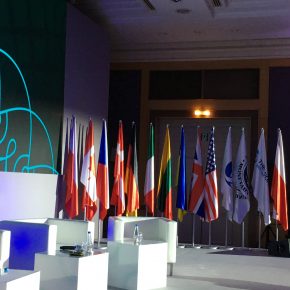Tydzień w gospodarce
Category: Trendy gospodarcze

Central Europe and the global value chains, stimulating innovation, challenges for the future growth were some of the issues addressed by the 6th annual “NBP Conference on the Future of the European Economy”, held in Warsaw, Poland.
The Governor of Poland’s central bank Narodowy Bank Polski, Prof. Adam Glapiński, in his opening speech, stressed that despite the success in transformation it’s too early to say that Central and Southeast Europe (CSE) is fully integrated with the Western Europe. “Nowadays, up to 1/2 of public investment is financed by the EU funds, and the biggest question is whether modernization will continue in the next budget perspective when these funds will be cut, also due to Brexit,” he said.
Hans Timmer, Chief Economist for Europe and Central Asia Region in the World Bank, is convinced that it’s impossible to say exactly what new sources of growth will be. “We have to keep in mind that after the financial crisis the world is different and more volatile. In the past opening up economies and globalization were seen as typical sources of growth, but today we are living in a new normal,” he says.
As disruption technologies are changing the way we all live and work thus education, human capital and innovation seem to be the natural sources of growth. “We need to refocus the economies from industry into services,” Timmer says, and most of conference participants agreed. “We all need to rethink social contracts, and find a way to intensify globalization,” he adds.
Prof. Svetla Marinova from the Aalborg University, is even more radical. “CEE countries have to learn that knowledge is an investment. R&D is an investment. Citizens of this region have to take a path that leads from individuals to teams and have to strengthened self-esteem. In the future we need to build knowledge-based capital, reconfigure traditional and implement new business models, explore innovation and increase organizational efficiency,” she says.
Oleh Havrylyshyn from the University of Toronto, disagrees. “The first phase of CEE growth was rather unconventional but the future growth has to be based on more conventional ways, such as growth of productivity, reforming institutions and technology,” he says. Havrylyshyn sees Central Europe and Baltic countries as the leaders in the region and a bridge for trade and investment with Eastern neighbors, including Russia.
“Former Soviet Union should be the goal for regional FDI. There are several advantages, such as low-paid with high-skill labor force, language and historical affinities, familiarity with systems, both formal and informal,” he adds.
According to Havrylyshyn there are several other actions CEE has to take to ensure further growth. Maintaining fiscal-monetary stability and complete institutional development are one of them. GDP should keep on improving positive investment climate, with investment in education of a key importance. There are also diplomatic and economic actions needed to create stable, thriving, and accessible Eastern markets.
Zdeněk Tůma, KPMG partner and former governor of the Czech National Bank, stresses that the region, and Czech Republic in particular, stopped its development at certain level, which, in case of his country, is approx. 60 per cent of Germany. “The biggest challenges to move forward are human capital and technology. 80 per cent of growth is based on technological progress,” he adds.
Kerstin Jorna, Deputy Director-General, Economic and Financial Affairs, European Commission, proposed further improvement of public services quality. “In this matter”, she says, “CEE is far beyond the rest of the EU.”
There is no doubt that Europe faces serious challenges, said Paweł Samecki, Member of the Board of Poland’s central bank, Narodowy Bank Polski. External and internal security, refugees crisis, Economic and Monetary Union governance and architecture are only the major ones. “The gravity of those challenges and the need to respond to them will not change the course of the EU integration process,” he stresses. “The most likely scenario is something between ‟Carrying on” (status quo) and ‟Those who want more do more” (multispeed EU),” says Samecki.
EU funds are responsible for 1/3 or even a half of the total public investment in CEE. But the major question is what will happen after 2020. It is possible that, due to Brexit and net contributors’ fatigue, the next EU budget will be lower than in 2014-2020. Samecki thinks the new Financial Perspective will have to focus on these three major challenges, hence, Common Agriculture Policy and cohesion policy will be reduced. “CSE will have to adjust and find new sources of financing investment, preferably by generating more domestic savings,” he adds.
According to Prof. Iain Begg from LSE, CEE countries are too addicted to EU funds. After Brexit many Western countries will not want to pay more to fulfill loss of UK contribution, and less money means less spending. “CEE needs to look for internal financing,” he says.
Moray Gilland, Head of Policy Development and Economic Analysis in the European Commission, disagrees. The disparities at regional level, even within CSE, are too big. The region is divided into countries with low-income (eastern part), and low-growth (southern part). So the cohesion policy must be continued after 2020. „This is why I’m less pessimistic on the size of the next budget, but certainly policy ‘one size doesn’t fit all’ has to be changed,” he says.
During all panels it was emphasized that the phenomena of low inflation and low interest rates in the CSE were of a local, rather than global, nature. The speakers agreed that in the present conditions the traditional monetary policy measures could still be efficient. It was argued that an extra stimulus for growth in the region could be provided by further liberalization of the services market and the removal of the remaining barriers in the EU services market. Furthermore, experts pointed out that the effects of globalization that are beneficial for society should be distributed more evenly among its citizens.
More information about the Conference can be found here.


